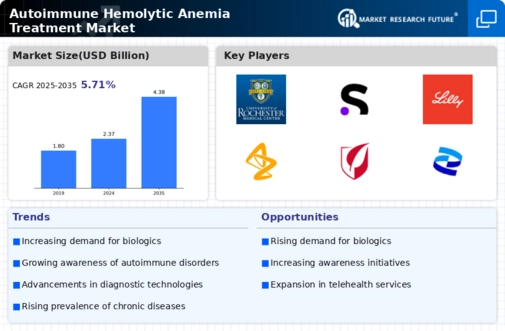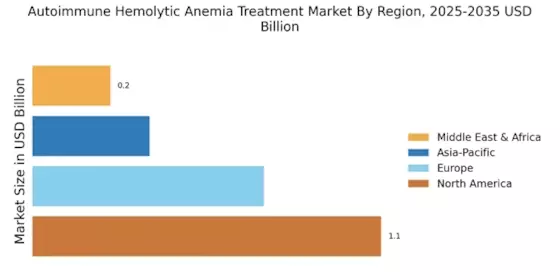Advancements in Diagnostic Technologies
Technological advancements in diagnostic tools are transforming the landscape of the Autoimmune Hemolytic Anemia Treatment Market. Enhanced diagnostic capabilities allow for earlier and more accurate identification of autoimmune hemolytic anemia, which is crucial for timely intervention. Innovations such as high-throughput screening and advanced imaging techniques are becoming increasingly prevalent, enabling healthcare professionals to diagnose conditions with greater precision. This shift not only facilitates better patient outcomes but also drives the demand for targeted therapies. As diagnostic technologies continue to evolve, they are likely to contribute to a more informed patient population, which in turn may lead to increased treatment uptake. The interplay between improved diagnostics and treatment options is expected to create a synergistic effect, further stimulating market growth.
Growing Investment in Biopharmaceuticals
The surge in investment within the biopharmaceutical sector is a significant driver for the Autoimmune Hemolytic Anemia Treatment Market. Biopharmaceuticals, including monoclonal antibodies and biologics, have shown promising results in treating autoimmune conditions. The market for biopharmaceuticals is projected to reach substantial figures, with estimates suggesting it could exceed USD 500 billion by 2025. This influx of capital is likely to accelerate the development of novel therapies specifically targeting autoimmune hemolytic anemia. As companies focus on creating more effective and personalized treatment options, the market is expected to witness a proliferation of innovative products. This trend indicates a robust future for the treatment landscape, as biopharmaceutical advancements continue to reshape therapeutic approaches.
Increased Patient Awareness and Advocacy
The rise in patient awareness and advocacy groups is playing a pivotal role in shaping the Autoimmune Hemolytic Anemia Treatment Market. As patients become more informed about their conditions, they are more likely to seek treatment and engage in discussions with healthcare providers. Advocacy organizations are instrumental in educating the public about autoimmune hemolytic anemia, which can lead to earlier diagnosis and treatment. This heightened awareness is likely to drive demand for effective therapies, as patients actively pursue options that can improve their quality of life. Furthermore, advocacy efforts often lead to increased funding for research and development, which can result in the introduction of new treatment modalities. The synergy between patient advocacy and market growth is expected to foster a more dynamic treatment environment.
Rising Incidence of Autoimmune Disorders
The increasing prevalence of autoimmune disorders, including autoimmune hemolytic anemia, is a notable driver for the Autoimmune Hemolytic Anemia Treatment Market. Recent data indicates that autoimmune diseases affect approximately 5-8% of the population, with hemolytic anemia being a significant subset. This rise in incidence is likely to escalate the demand for effective treatment options, thereby propelling market growth. As healthcare providers become more adept at diagnosing these conditions, the number of patients seeking treatment is expected to increase. Consequently, pharmaceutical companies are likely to invest in research and development to create innovative therapies tailored to this patient demographic. This trend suggests a robust market potential for treatments specifically targeting autoimmune hemolytic anemia, as awareness and diagnosis improve.
Regulatory Support for Innovative Therapies
Regulatory bodies are increasingly supportive of innovative therapies for autoimmune conditions, which is a crucial driver for the Autoimmune Hemolytic Anemia Treatment Market. Initiatives aimed at expediting the approval process for new treatments are becoming more common, allowing for faster access to potentially life-saving therapies. This regulatory environment encourages pharmaceutical companies to invest in research and development, knowing that their innovations may reach the market more swiftly. The introduction of programs such as breakthrough therapy designations and accelerated approval pathways is likely to enhance the availability of novel treatments for autoimmune hemolytic anemia. As a result, the market may experience a surge in new product launches, contributing to a more diverse and effective treatment landscape.


















Leave a Comment